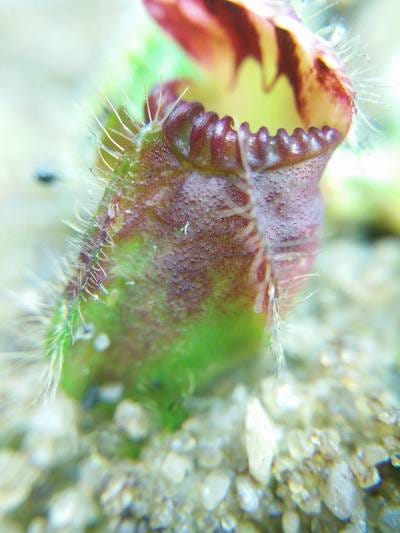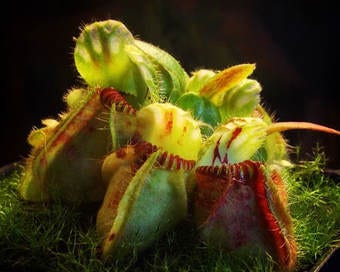GROWING CEPHALOTUS FOLLICULARIS
Introduction
Cephalotus follicularis is another member of a monotypic genus, just like the Venus flytrap. Its tendency to stay small and compact makes it a great candidate for a cool terrarium, and its unique morphology and distant taxonomic placement relative to other carnivorous plants (a classic example of convergent evolution) makes it attractive to collectors. It naturally occurs in moist peaty sands along streams or creeks in coastal Southwest Australia, sometimes growing right up to the shoreline. They experience warm day temperatures somewhere around the order of 80F with cool nights during the growing season, along with episodes of brief frosts in the winter. The plant produces average-looking non-carnivorous leaves mainly geared for photosynthesis as well as hairy pitchers that resemble bizarre moccasins. It can be a little tricky to maintain in cultivation, but with the proper conditions and a little bit of babying it can be grown well. My (admittedly limited) experience with the plant tells me that it isn't hideously difficult to grow as I have seen suggested.
Lighting and Temperature
Cephalotus grow best and color up the most with a lot of light. The plants tend to grow larger and greener pitchers in the shade. Growers report that the plants are capable of tolerating light frosts; I have not tried this with my own plants, but I don't doubt it considering plants in situ have to undergo similar temperatures. The plants prefer cooler temperatures in cultivation. If the day temperatures are to exceed around 80F or so, the plants will need cooler temperatures at night (like they receive in their natural habitat). My Cephalotus experience around 85F highs in the summer with nighttime lows of 60F. In the winter, the daytime temperature does not exceed 75F and the nighttime temperature typically hovers around 50F. I also lower the photoperiod during this time in an attempt to simulate the seasonal changes of their natural environment. Growth slows down during this period and the plant tends to produce more non-carnivorous leaves.
Medium
I keep my plants in an airy mixture of perlite, sand, and some peat. Other growers keep their plants in substrates ranging from live Sphagnum, dead Sphagnum, peat/sand and peat-based mixes, turface, volcanic rock derivatives, and other convoluted things. I recall one grower who successfully grew Cephalotus in Miracle-Gro brand potting soil. Some growers also like to top-dress their plants with sand or live Sphagnum. Whenever someone asks for a preferred Cephalotus soil recipe, they are bombarded with a myriad of different responses. I think the takeaway from all of this is that the soil mix you choose should be one that suits your conditions the most. Healthy Cephalotus should maintain fluid in the pitchers - if the pitchers are dry, increase the organic matter. If the plants rot, keep them less wet and try an airier mix. Growing Cephalotus will likely require lots of experimentation on your part.
Feeding and Fertilization
The obvious way to feed Cephalotus is to simply place comfortably-sized insects in active pitchers. Fish food pellets or pelletized fertilizers like Osmocote also work (be careful not to overfeed or you will burn the pitcher). A few months ago I began watering my plants with the same orchid fertilizer I use on my Nepenthes, diluted to 1/4 strength. I could not discern any particular improvement in growth due to the lack of a large sample size and control group, but the plants weren't harmed at least. I have also grown plants in a mix containing significant proportions of (unwashed) Miracle-Gro perlite with no ill effects. Cephalotus appear to be much more tolerant of nutrients in their soil than Drosera and Dionaea.

Propagation
So far, I have only attempted propagation of Cephalotus through crown divisions I took while repotting, all of which established themselves successfully. I simply buried the end of the rhizome (with roots attached) in my normal substrate, bagged the pot to prevent desiccation, and placed it with my other plants until new growth appeared. Other methods include propagation by leaf/pitcher pullings (more popular) and by seed (less popular). Cephalotus also takes well to tissue culture. The availability of Cephalotus seems to have really increased in the last few years, while the price has gone down. I have no doubt that the increasing numbers of tissue-cultured Cephalotus nowadays has played a large part in that.








